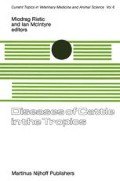Abstract
Cattle are infected by at least five species of Theileria other than T. parva, of which T. annulata, the cause of Mediterranean or tropical theileriosis, is by far the most important as a disease problem. Other species are of low pathogenicity (T. mutans, T. taurotragi) or avirulent (T. velifera) and cause benign theileriosis while other yet unidentified, mostly non pathogenic theilerias occur on all continents and are possibly related to the T. sergenti/T. orientalis group of the far eastern USSR, the agents of East Asian theileriosis. Hyalomma ticks are the vectors of T. annulata while mainly Amblyomma, Rhipicephalus and Haemaphysalis spp. are involved in the transmission of other species of the organism.
Imported European breeds are far more susceptible to Mediterranean theileriosis than local cattle in endemic regions, which may live with the disease in a state of endemic stability.
Mediterranean theileriosis is an acute febrile disease in susceptible cattle, with a mortality rate which may reach 70%. Involvement of lymphoid tissue is caused by invasion by the schizontic stage, anemia is associated with the erythrocytic piroplasm stage. The course, the post-mortem lesions and the pathogenesis of the various theilerial infections are reviewed.
Recovery from infection by all species concerned is followed by the piroplasm carrier state, but persistence of the parasite is not necessary for immunity, which may last several years. Humoral antibodies are unimportant in protection and immunity is likely to be cell-mediated.
Presumptive diagnosis on clinical signs and post mortem lesions require parasitological confirmation based on demonstrating schizonts and/or a high parasitemia. In addition to morphological characteristics, serological techniques are necessary for species differentiation.
Intensive short-interval acaricidal treatment prevents transmission of theileriosis but there are numerous problems associated with tick control, and effective methods of immunization and treatment are required. Immunization against T. annulata is carried out in some countries, using attenuated schizonts grown in cell culture. Sporozoite vaccine promises to be even more effective. The occurrence of immunologically different strains is a complicating factor in immunization. Certain antimalarial drugs affect the erythrocytic stage of Theileria, while the only schizonticidal drug on the market is the recent coccidiostat halofuginone.
Access this chapter
Tax calculation will be finalised at checkout
Purchases are for personal use only
Preview
Unable to display preview. Download preview PDF.
References
Barnett SF: Theileriasis. In: Infectious Blood Diseases of Man and Animals. Diseases Caused by Protista, Vol II, pp 269–328. Weinman D and Ristic M, eds. New York: Academic Press, 1968.
Barnett SF: The//er/a. In: Parasitic Protozoa, Vol IV, pp 77–113. Kreier JP, ed. New York: Academic Press, 1977.
Gamaleev AD: Interrelationship between ixodid ticks and Theileria in biocenoses of the Far East. In: Veterinary Nosogeography, pp 50–67. Gamaleev AD and Geletyuk VZ, eds. Mater. 2. Konf. Probl. Med. Geogr. Dal’n. Vost. (Vladivostok): (1973) (Translation 1267, Medical Zoology Department, NAMRU-3, Cairo).
Gill BS, Bhattacharyulu Y, Kaur D: Symptoms and pathology of experimental bovine tropical theileriosis (Theileria annulata infection). Ann Parasitol Hum Comp 52: 597608, 1977.
Gill BS, Bhattacharyulu Y, Kaur D, Singh A: Chemoprophylaxis with tetracycline drugs in the immunisation of cattle against Theileria annulata infection. Int J Parasitol 8: 467–469, 1978.
Grootenhuis JG: Theileriosis of wild Bovidae in Kenya with special reference to the eland (Taurotragus oryx). Ph.D. Thesis, Veterinary Faculty, Utrecht, the Netherlands, 1979.
Grootenhuis JG, Young AS, Uilenberg G: Theileria species with low pathogenicity for cattle: The relationship between Theileria taurotragi from eland and Theileria species (Idobogo) from cattle. Vet Parasitol, in press.
Ishihara T: Bovine piroplasmosis in Japan. Jap Agric Res Q 3(3):23–31, 1968. Markov AA: Les theilérioses (gondérioses). Bull Off Int Epiz 58:165–193, 1962. Neitz WO: Theileriosis, gonderioses and cytauxzoonoses: a review. Onderstepoort J
Vet Res 27:275–430, 1957.
Pipano E: Immunological aspects of Theileria annulata infection. Bull Off Int Epiz 81: 139–159, 1974.
Pipano E: Basic principles of Theileria annulata control. In: Theileriosis, pp 55–65. Henson JB and Campbell M, eds. Rep. Workshop Nairobi, 1976. IDRC, Ottawa, 1977 a.
Pipano E: Current status of Theileria annulata research with special reference to control of tropical theileriosis. Situation Paper AGA: TD/77/1 for Second FAO Expert Consultation on Research on Tick-Borne Diseases and Their Vectors. Rome: FAO, 1977b.
Samish M: Infective Theileria annulata in the tick without a blood meal stimulus. Nature 270: 51–52, 1977.
Schein E, Voigt WP: Chemotherapy of bovine theileriosis with Halofuginone. Short communication. Acta Trop 36: 391–394, 1979.
Sergent E, Donatien A, Parrot L, Lestoquard F: Etudes sur les piroplasmoses. Alger: Institut Pasteur d’Algérie, 1945.
Van Vorstenbosch CJAHV, Uilenberg G, Van Dijk JE: Erythrocytic forms of Theileria velifera. Res, Vet Sci 24: 214–221, 1978.
Wilde JKH: Tick-borne diseases and their vectors. Proc Int Conf Edinburgh, 1976. Edinburgh: University Press, 1978.
Young AS, Grootenhuis JG, Smith K, Flowers MJ, Dolan TT, Brocklesby DW: Structures associated with Theileria parasites in eland erythrocytes. Ann Trop Med Parasitol 72: 443–454, 1978a.
Young AS, Purnell RE, Payne RC, Brown CGD, Kanhai GK: Studies on the transmission and course of infection of a Kenyan strain of Theileria mutans. Parasitology 76: 99–115, 1978b.
Zolotarev NA: Hemosporidioses of cattle. In: Parasitology and Parasitic Diseases of Livestock, pp 372–408. Moscow: State Publishing House for Agricultural Literature, 1956 ( Translation, Israel Program for Scientific Translations, Jerusalem, 1960 ).
Editor information
Editors and Affiliations
Rights and permissions
Copyright information
© 1981 Martinus Nijhoff Publishers, The Hague
About this chapter
Cite this chapter
Uilenberg, G. (1981). Theileria Infections other than East Coast Fever. In: Ristic, M., McIntyre, W.I.M. (eds) Diseases of Cattle in the Tropics. Current Topics in Veterinary Medicine and Animal Science, vol 6. Springer, Dordrecht. https://doi.org/10.1007/978-94-011-9034-3_33
Download citation
DOI: https://doi.org/10.1007/978-94-011-9034-3_33
Publisher Name: Springer, Dordrecht
Print ISBN: 978-94-011-8352-9
Online ISBN: 978-94-011-9034-3
eBook Packages: Springer Book Archive

